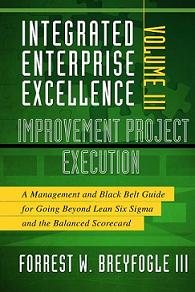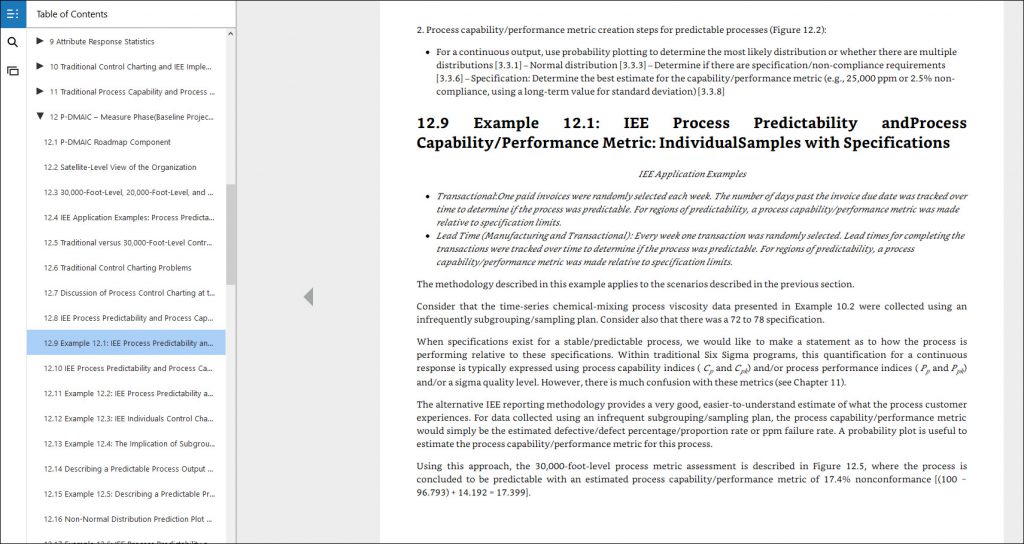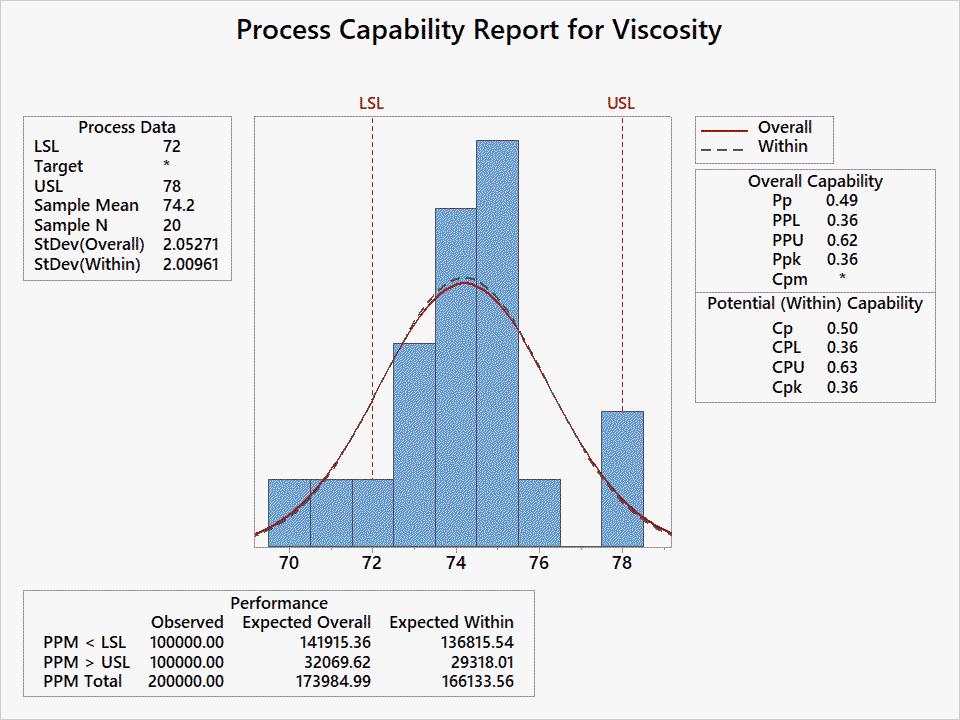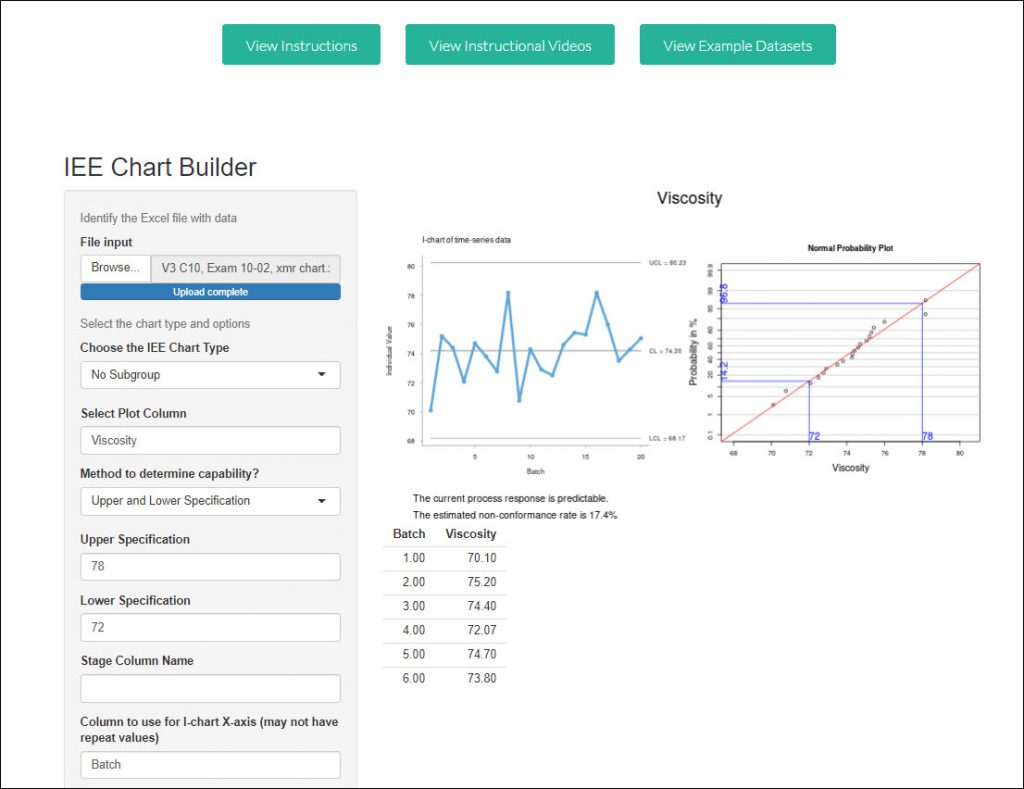This process capability analysis example discusses a Cp, Cpk, Pp, & Ppk (process capability and process performance) index report-out and the advantages of a 30,000-foot-level reporting alternative.
Someone showed me how their organization was making pass/fail decisions for a product batch by evaluating a test sample against a minimum process capability index criterion. This organization was wasting a tremendous amount of money and not fixing its product problems.
The following describes the technical problems with their process capability indices and process performance indices (Cp, Cpk, Pp, and Ppk) test plan against a minimum criterion of 1.33 and what to do to resolve these issues.
The dataset used in this example is from Integrated Enterprise Excellence Volume III – Improvement Project Execution: A Management and Black Belt Guide for Going Beyond Lean Six Sigma and the Balanced Scorecard.

Process Capability Analysis Example: Similar Application Situations and Dataset
The following figure shows a screenshot of IEE Volume III. This image describes potential applications of the following 30,000-foot-level reporting methodology beyond the measurement of batch viscosity over time.

The time-series dataset used in the creation of this book-example process capability analysis is:

Process Capability and Process Performance Index Equations
Process capability and process performance indices (i.e., Cp, Cpk, Pp, and Ppk) are to describe how a process is performing relative to customer specifications. The standard deviation denominator value in Cp and Cpk equations depends on the process sampling approach for data collection; e.g., an XmR control chart source is different than an x-bar and R control chart source.
Process capability indices are the ratio of the spread of the customer specification divided by six times the standard deviation (sigma) of the process variability. For Cp and Cpk calculations, the standard deviation is to be short term. For Pp and Ppk calculations, the standard deviation is to be long term. The difference between Cp and Cpk is that Cp examines the spread of specification to data spread. Cpk considers how the data are positioned relative to specification limits. Pp and Ppk have a similar relationship.
Equations for Cp and Cpk calculations are:

Understanding throughout an organization how well a process is performing relative to customer needs is difficult using process capability indices. Later is presented a much better approach for determining and reporting the capability of a process.
Process Capability Analysis Example: Traditional Cp, Cpk, Pp, and Ppk Report-out
A process is to be stable before conducting a process capability study index. The following control chart indicates the process has no out-of-control conditions; hence, a process capability analysis for this process response-output data is appropriate.

A statistical-software process capability report that shows calculated values for Cp, Cpk, Pp, and Ppk for this process output that has a specification of 72-78 is:

The process capability indices from this report-out are unsatisfactory according to the Cp, Cpk, Pp, and Ppk minimum-value criteria (e.g., 1.33) that many organizations might have. However, how bad is the output of this process relative to achieving a specified customer specification desire of 72-78? From this capability analysis report-out, what should someone do after seeing these process capability report-out values? It is hard to tell and also explain this report to others throughout an organization.
The following video summarizes problems with traditional process capability indices reporting and provides a 30,000-foot-level reporting alternative that addresses these issues (and more).
The following includes much of the video content and more.
Process Capability Analysis Example: 30,000-foot-level Report Alternative and Benefits
Figure 12.5 in Integrated Enterprise Excellence (IEE) Volume III shows a 30,000-foot-level report-out alternative to a traditional process capability indices report:

For this process capability analysis example, the individuals chart (left-reported chart of the two-chart pair) indicates process stability since there are no datum points beyond the data-calculated upper and lower control limits (UCL and LCL). With high-level process output 30,000-foot-level level reporting, a stable process is considered predictable. The probability plot (right-reported chart of the two-chart pair) provides a non-conformance rate estimate for a specification of 72 and 78 by adding the estimated percentage of occurrences below and above the specification limits to determine the prediction statement. The bottom of the two-chart-reporting-pair reports this determined estimate of a 17.4% non-conformance rate. NOTE: the percentage of 17.4% is the same as the traditional process-capability report-out parts per million (PPM) Expected Overall value of 173984.99 expressed as a percentage.
If this rate (now and future prediction) response is undesirable, this unsatisfactory measured performance suggests undertaking a process improvement effort. This reporting contrasts to possible “why occurrence” of the common-cause individual points up and down variation in the time-series chart.
Advantage of this 30,000-foot-level report over a traditional process capability analysis includes:
- It provides the results from a process control chart and capability index calculator in the same chart. This combination of traditional report-outs in one report-out is essential. A process capability index calculation of Cp, Cpk, Pp, and Ppk alone does not provide information as to whether the process is in control or not. If the assessed process is not in control, calculated process capability indices are invalid.
- It describes the capability of a process capability at the bottom of the two-chart pair in terms that everyone can easily understand. A 30,000-foot-level estimated reported rate of 17.4% is much easier to understand than reported values for Cp, Cpk, Pp, and Ppk of 0.50, 0.36, 0.49, and 0.36.
- It provides for a stable process a process capability statement that is a prediction statement.
- It supplies a means to identify when a process improvement occurs through a staging of the individuals chart (left output chart). The associated probability plot of the two-chart pair would provide a process capability statement for any after-staging data.
- It can easily address non-normal data situations, reporting process capability in words that everyone can easily understand; e.g., estimated non-conformance rate. A log-normal distribution plot is often more appropriate to model a process output response than an normal distribution plot when there is a natural boundary such as zero; e.g., time to complete a task or flatness of a part.
- It can also be used to track overall business metrics; e.g., monthly profit margins, on-time delivery, and customer satisfaction.
The following figure illustrates the result of applying a free app (that anyone can use for tracking the output of their processes) to create a 30,000-foot-level report-out, similar to Figure 12.5 in Integrated Enterprise Excellence (IEE) Volume III.

This image’s bottom-of-the-chart futuristic reporting is consistent with the non-conformance rate shown in Figure 12.5 of IEE Vol III with the 17.4% reported percentage. If one were to right-click on the image in this app, they could save the graph as a PNG file to use elsewhere; e.g., a PowerPoint presentation or Word Document.
Process Performance Indicators Example Application: IEE Volume II and III
There are descriptions of applying 30,000-foot-level continuous response reporting for both Lean Six Sigma project metrics AND business KPI reporting in a 4-book IEE Series. The IEE Volume II in the set provides details for applying KPI reporting techniques at the business level. The IEE Volume III describes using the above process-output-response-metric-reporting techniques at the Lean Six Sigma improvement project execution level. A project’s metric baseline would occur in the measure phase of the Define-Measure-Analyze-Improve-Control (DMAIC) roadmap.

Over 140 Datasets and Solutions Manual
The IEE Volume III Solutions Manual provides over 140 datasets. One can use the above-described app to re-create the 30,000-foot-level metric report-outs in the IEE Volume II and IEE Volume III books, i.e., as described in the above process performance indicators example.
DMAIC Tools Integration
In applying Lean and Six Sigma, it is vital to use the right tool at the right time. The book Lean Six Sigma Project Execution Guide: The Integrated Enterprise Excellence (IEE) Process Improvement Project Roadmap provides a Roadmap for accomplishing this essential objective.
Summary
What additional process insight could you gain from the application of the above described 30,000-foot-level reporting app? This amount of understanding could be huge.

Contact Us through an e-mail or telephone call to set up a time for a discussion on how your organization might gain much from an Integrated Enterprise Excellence Business Process Management system. Or, a Zoom meeting can be schedule directly:
E-mail ([email protected]) or call us (+1.512.918.0280), if you encounter difficulties setting up a Zoom session directly or want to schedule another time that is not available in the Zoom-meeting calendar.



